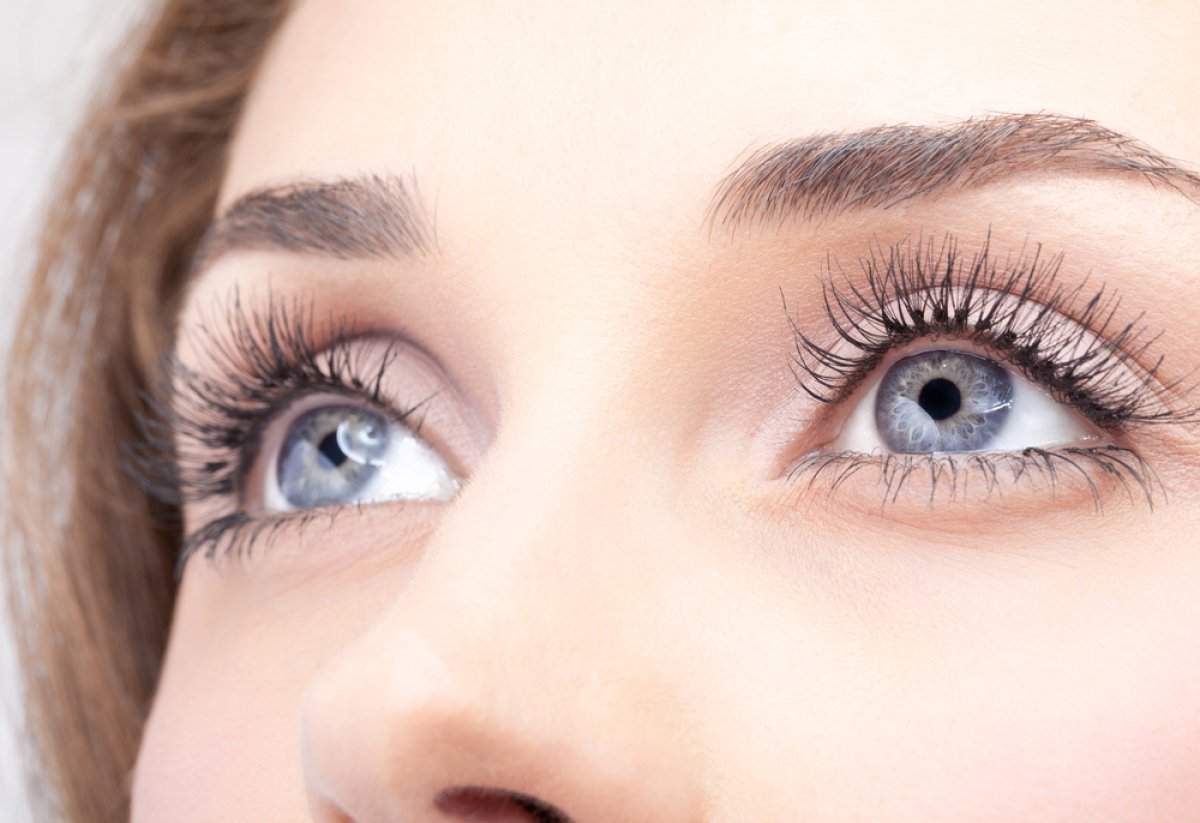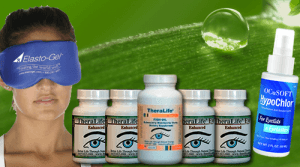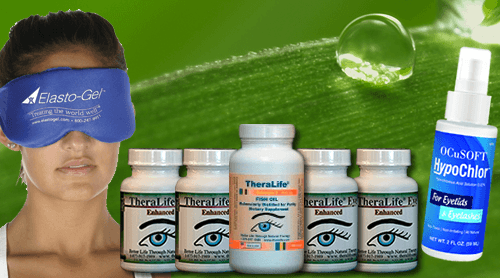To effectively manage eyelid inflammation and watery eyes, consider TheraLife’s comprehensive range of products that promote eye health and provide relief from discomfort. TheraLife emphasizes meticulous eyelid hygiene with natural ingredients, offering solutions like warm compresses and gentle cleansers to soothe irritation. Their products are designed to shield against allergens, reducing the impact of common triggers such as dust and smoke.
TheraLife’s tailored treatments extend to natural supplements that support eye health by addressing underlying systemic conditions, thus preventing future flare-ups. These supplements can benefit those dealing with blepharitis, dry eyes, and other related conditions. Additionally, TheraLife suggests using air purifiers and humidifiers as environmental modifications to minimize irritants.
For those experiencing bacterial infections or severe symptoms, TheraLife provides insights into when medical consultation for treatments like antibiotics or steroid drops may be necessary. The consistent implementation of TheraLife’s strategies, including their unique product offerings, can greatly mitigate discomfort and enhance your overall eye health. Discovering these strategies through TheraLife’s resources can further improve your results and quality of life.
Best Blepharitis Treatment From TheraLife
Key Takeaways
- Regularly clean eyelids with a warm compress and non-irritating shampoo solution to reduce inflammation.
- Use protective eyewear to minimize exposure to allergens and irritants, preventing exacerbation of symptoms.
- Implement air purifiers and maintain indoor humidity to improve air quality and prevent dry eyes.
- Seek medical evaluation for persistent symptoms; consider topical antibiotics or steroid treatments if necessary.
- Identify and avoid specific allergens and irritants, tailoring lifestyle changes to reduce symptom recurrence.
Understanding Eyelid Inflammation
When it comes to understanding eyelid inflammation, it’s vital to identify the various causes and risk factors involved.
Eyelid anatomy plays a significant role in the inflammation types. Anterior eyelid inflammation manifests near the eyelashes and is typically triggered by dandruff, allergic reactions, or mites.
On the other hand, posterior eyelid inflammation occurs at the inner edge, often due to malfunctioning oil glands. Both types can arise from bacterial infections or medication side effects. People experiencing symptoms should seek a diagnosis from family doctors or eye specialists, as they can perform a physical examination of the eye to determine the condition. Proper eyelid hygiene is crucial in managing inflammation, as routine cleaning can help reduce symptoms and prevent recurrence.
Individuals with oily skin or dandruff are particularly susceptible. Blepharitis, affecting up to 25% of patients seen by eye care professionals, frequently results from these conditions.
Recognizing these specific inflammation types and their links to the eyelid’s anatomical features is essential for proper management and prevention.
Common Symptoms to Recognize
Recognizing the common symptoms of eyelid inflammation is vital for effective management and prevention of further complications.
You’ll notice red, swollen eyelids, which may exhibit crustiness due to accumulated discharge. Itchy sensations often accompany this, along with a gritty or burning feeling that compromises eye comfort. Proper eyelid care is essential to address these symptoms and prevent escalation. Keeping excessive bacteria accumulation in check by maintaining eyelid hygiene is a crucial step in managing inflammation and avoiding long-term issues. Immune inflammatory mechanisms play a crucial role in exacerbating symptoms and should be addressed through appropriate treatments.
Watery eyes present as excessive tearing, often blurring your vision until you blink. Light sensitivity and a foreign body sensation can occur, giving the eyelids a greasy appearance.
Associated conditions like chalazion or stye manifest as lumps, while chronic issues can lead to complications such as increased infection risk or corneal damage. Understanding these symptoms helps guarantee your eyelid care effectively maintains eye comfort.
Causes of Watery Eyes
When considering the causes of watery eyes, it’s vital to recognize the role of common trigger factors such as allergies, environmental changes, and nasal conditions.
Allergic reactions, for instance, can lead to increased tear production due to inflammation in the conjunctiva and nasal passages. Protective eyewear can reduce exposure to allergens and other irritants, thereby minimizing allergic reactions and excessive tearing.
Additionally, risk factors like age-related changes in eyelid and tear duct function, as well as specific eye conditions and infections, further contribute to the complexity of this condition. In older adults, sagging eyelid skin can prevent tears from draining properly into the nose, leading to excessive tearing.
Common Trigger Factors
Although often overlooked, understanding the common trigger factors for watery eyes is essential for effective management. Allergy triggers like mold, dander, and dust can initiate excessive tearing, while environmental changes such as moving into a new house or starting a job expose you to new irritants.
Smog, bright light, and foreign particles, like dust or sand, also contribute to this condition. It’s important to note that insufficient tear production or increased tear evaporation can lead to dry eyes, which sometimes paradoxically causes excessive tearing as the eyes try to compensate.
It’s vital to recognize that anatomical factors play a role as well. Aging can affect eyelid elasticity, leading to improper tear drainage. Conditions like blepharitis and conjunctivitis cause inflammation, further complicating tear production. Excessive tear production can also be a response to these conditions, as the eyes attempt to flush out irritants.
Additionally, tear duct blockages and the presence of inward-growing eyelashes are common culprits. By identifying these triggers, you can better manage and prevent watery eyes.
Risk and Conditions
While the causes of watery eyes are diverse, understanding the underlying risks and conditions is essential for effective management. Risk assessment begins with identifying common culprits like blocked tear ducts, which affect both children and older adults due to developmental or age-related changes. Trauma and infections also contribute to blockage, disrupting tear drainage. Conditions like entropion, ectropion, and chronic infections like dacryocystitis can lead to persistent tearing. Overproduction of tears often results from dry eye syndrome, where irritation triggers reflex tears. Allergic reactions and environmental irritants like dust or smoke further exacerbate tearing. Aging contributes to decreased tear quality, causing compensatory overproduction. Symptoms of watery eyes may include eye irritation or pain depending on the underlying causes. Effective condition management requires addressing these underlying causes, whether they’re anatomical, environmental, or age-related, to reduce persistent watery eyes. Understanding the role of meibomian gland dysfunction in tear film stability and eye health can further aid in managing excessive tearing.
Risk Factors to Consider
Understanding the risk factors for eyelid inflammation is essential for effective management and prevention strategies. Genetic predispositions can greatly influence your likelihood of experiencing eyelid inflammation and watery eyes. If there’s a family history of eye conditions, you’re more prone to developing similar issues. Environmental irritants like pollen, dust, and pet dander are well-documented triggers. They can exacerbate allergic reactions, leading to inflammation. It’s important to note that allergies affect up to 40% of adults, which makes awareness and management critical. Systemic conditions such as thyroid disorders and autoimmune diseases like rheumatoid arthritis also elevate your risk. Sjögren’s syndrome, an autoimmune disease primarily affecting women, can manifest as dryness and inflammation, contributing to eyelid issues. These conditions can cause inflammation and fluid retention, impacting eyelid health. Additionally, cosmetics and contact lens-related risks are prevalent. Verify you’re using hypoallergenic and non-expired products to minimize bacterial infections. Recognize these factors to implement proactive measures against eyelid inflammation.
Best Blepharitis Treatment From TheraLife
Effective Hygiene Practices
Implementing effective hygiene practices is essential for managing eyelid inflammation and preventing further complications. Begin your daily routine with a warm compress to your eyelids for five minutes, which improves circulation and loosens crusty deposits. Follow up with an eyelid scrub using a non-irritating shampoo solution. Use a clean, soft cloth to gently wipe the eyelids, ensuring you use separate cloths for each eye to prevent cross-contamination. Consistent eyelid hygiene helps control blepharitis and prevents styes. Additionally, maintain overall cleanliness by washing your face and scalp regularly. Remember, accumulation of dirt on the eyelids can lead to bacterial infestations, so keeping your eyelids clean is crucial. Avoid irritants like contact lenses and eye makeup during flare-ups. Establishing these practices as part of your daily routine is pivotal in managing symptoms effectively. Using TheraLife products can also aid in controlling blepharitis effectively, offering a comprehensive solution for those dealing with dry eyes and eyelid inflammation.
Medical Treatment Options
When managing eyelid inflammation, a thorough understanding of medical treatment options is essential. Antibiotic options include topical applications like erythromycin or Polysporin, effective against eyelid bacterial infections. For severe cases, oral antibiotics such as doxycycline might be necessary. To reduce inflammation, steroid eyedrops or creams, often paired with antibiotics, are beneficial. Causes of blepharitis include bacteria, skin conditions, or blocked oil glands, which require specific medical interventions to manage effectively. For those experiencing Meibomian Gland Dysfunction, lifestyle changes such as maintaining proper eyelid hygiene and limiting contact lens wear can significantly reduce symptoms. Procedural therapies offer additional treatments:
- Intense pulsed light (IPL) therapy liquefies Meibomian gland obstructions, improving oil secretion and reducing redness.
- Thermal pulsation therapy applies heat and massage to enhance oil secretion and clear blockages.
- Microblepharoexfoliation gently exfoliates eyelash biofilm and demodex infestations.
These medical interventions, tailored to individual needs, can effectively address both inflammation and infection, promoting eyelid health and comfort.
Environmental Adjustments
While managing eyelid inflammation, environmental adjustments play an essential role in mitigating symptoms and preventing flare-ups.
Improving air quality is critical. Use HEPA and activated carbon filters to trap allergens and pollutants. Maintain indoor humidity with humidifiers to prevent dry eyes. Additionally, limit exposure to smoking and second-hand smoke to reduce irritation. Prolonged exposure to dry conditions can lead to eye fatigue and decreased productivity, so keeping moisture levels balanced is essential for eye comfort. Using a hot compress for eyes can offer relief from dry eye symptoms, enhancing comfort and gland function.
For UV protection, wear sunglasses blocking 100% of UV rays. Polarized lenses can further shield your eyes during outdoor activities. Educate yourself on the dangers of UV radiation, as it exacerbates inflammation. Avoid direct sunlight exposure by staying indoors during peak hours.
Finally, wrap-around sunglasses protect against allergens and pollen, minimizing contact and reducing symptoms.
These strategies collectively enhance comfort and eye health.
Preventing Future Irritation
To effectively prevent future irritation of the eyelids, focus on maintaining proper eyelid hygiene and avoiding known triggers.
Clean your eyelids regularly using a warm compress to loosen crusts, followed by a diluted baby shampoo solution. Rinse thoroughly to remove any residue. Incorporating an all-natural eye wash like the Eyelid And Eyelash Cleanser can also be beneficial for maintaining cleanliness and reducing irritation.
Dietary adjustments are essential; incorporate foods rich in omega-3 fatty acids to mitigate inflammation. Protective eyewear can shield your eyes from environmental irritants. The thin skin of the eyelids contains many blood vessels, increasing sensitivity and susceptibility to irritation.
- Avoid touching your eyes with unwashed hands and remove makeup before sleeping.
- Identify irritants in skincare and opt for gentle, hypoallergenic products.
- Wear protective eyewear in environments with potential irritants to safeguard your eyes.
Managing at Home Remedies
To manage eyelid inflammation effectively at home, you should apply a warm compress, which helps open up blocked glands and alleviate discomfort through gentle heat therapy.
Practicing gentle eyelid cleansing with a mild, hypoallergenic cleanser can remove debris and reduce bacterial load, minimizing irritation.
Additionally, avoiding exposure to known irritants, such as allergens or harsh chemicals, is essential in preventing exacerbation of symptoms and promoting healing.
Warm Compress Technique
A warm compress is a practical and effective home remedy for managing eyelid inflammation. It offers several benefits, such as moisturizing dry eyes, improving oil flow by unblocking glands, and providing quick relief from redness and discomfort.
To maximize these warm compress benefits, apply it with proper frequency. Here’s how:
- Frequency: Use the compress twice daily, morning and night, for best results.
- Duration: Keep it on your closed eyelids for 5-10 minutes each session.
- Repetition: Repeat this procedure several times a day for styes or chalazia.
Prepare your compress by soaking a clean, chemical-free washcloth in warm (not hot) water.
Apply it safely, ensuring you avoid burns and use separate washcloths for each eye to prevent infection.
Gentle Eyelid Cleansing
While warm compresses provide immediate relief for eyelid inflammation, incorporating gentle eyelid cleansing into your routine offers long-term management benefits.
Start by ensuring proper eyelid hygiene, vital to reduce inflammation and prevent debris buildup. Begin your cleansing routine by washing your hands thoroughly. Use a fresh cloth or pad for each eye to avoid bacterial spread.
Opt for a mild, specially formulated eyelid cleanser or a homemade solution with warm water and non-irritating shampoo. Close one eye, gently apply the solution to the eyelid edge, and massage to dislodge debris. Rinse with cool water.
For precision, use cotton swabs, especially around the lashes. Remember, regular cleansing aids in long-term relief and should be done gently to avoid irritation.
Avoiding Irritant Exposure
One effective strategy for managing eyelid inflammation at home is to minimize exposure to common irritants like pollen, dust mites, pet dander, mold, and smoke.
Start with irritant identification to understand your triggers. Once identified, implement allergen management strategies to reduce exposure.
- Indoor Strategies: Utilize air purifiers equipped with HEPA filters and maintain a regular cleaning schedule focusing on dust and pet dander.
- Outdoor Strategies: Limit outdoor activities during peak pollen times and keep windows closed during high pollen seasons.
- Environmental Control: Use air conditioning to filter and circulate clean air inside your home.
These detailed methods can greatly decrease irritant exposure, helping to alleviate eyelid inflammation and watery eyes.
Employing these strategies not only provides immediate relief but also contributes to long-term eye health.
Complications to Watch For
When managing eyelid inflammation, it is crucial to be aware of potential complications that can arise and impact eye health. Eyelash issues, such as loss or misdirection, can exacerbate inflammation, leading to scarring. Poor tear quality is another complication, where abnormal secretions disrupt tear film, causing dry eyes or excessive tearing.
| Complication | Cause | Effect |
|---|---|---|
| Eyelash Problems | Inflammation, abnormal growth | Scarring, color loss |
| Tear Quality Issues | Abnormal secretions, inadequate film | Dry eyes, vision disruption |
| Secondary Infections | Blocked oil glands | Stye, chalazion formation |
| Chronic Pink Eye | Recurrent blepharitis | Persistent discomfort |
| Corneal Damage | Misdirected eyelashes, insufficient tears | Risk of infection, vision problems |
Secondary infections like styes or chalazions indicate gland blockages. Chronic conditions may lead to pink eye or corneal damage, increasing the risk of infection and vision issues.
Best Blepharitis Treatment From TheraLife
Frequently Asked Questions
Can Stress Worsen Eyelid Inflammation and Watery Eyes?
Yes, stress can worsen eyelid inflammation and watery eyes.
Psychological stress triggers inflammatory responses and weakens your immune system, making you more susceptible to conditions like blepharitis. This emotional impact can disrupt tear production, exacerbating symptoms.
Effective stress management, including techniques like meditation and lifestyle adjustments, can mitigate these effects. By controlling stress, you support your body’s ability to regulate inflammation, thereby improving your overall eye health and reducing discomfort.
Are There Any Natural Remedies for Eyelid Inflammation?
You’re seeking natural remedies for eyelid inflammation, and herbal treatments can offer relief.
Start with cool cucumber slices or green tea bags for their anti-inflammatory effects. Use a warm compress to unblock glands and relieve dryness.
Aloe vera gel provides a soothing touch, while castor oil reduces swelling.
Stay hydrated and rest adequately, ensuring your body naturally heals.
With these methods, you’re actively managing symptoms and promoting eye health.
How Does Diet Impact Eyelid Inflammation?
Your diet greatly impacts eyelid inflammation through anti-inflammatory foods and hydration.
Consuming omega-3 fatty acids from fish or flaxseeds reduces inflammation in tear ducts. Green leafy vegetables, nuts, and whole grains help combat inflammation, while processed foods and dairy exacerbate it.
Staying hydrated is essential for maintaining tear production, as water supports eye health.
Evidence suggests that these dietary choices can effectively manage inflammation, promoting overall eye wellness.
Can Wearing Contact Lenses Affect Eyelid Inflammation?
Wearing contact lenses can indeed affect eyelid inflammation.
Poor contact lens hygiene and unsuitable lens material types might contribute to conditions like Giant Papillary Conjunctivitis. When lenses aren’t cleaned properly, bacteria can accumulate, exacerbating inflammation.
Also, some lens materials may reduce oxygen to the cornea, causing hypoxia and swelling.
Confirm your lenses fit well and choose materials that support oxygen permeability to minimize inflammation risks related to contact lens use.
Is Eyelid Inflammation Contagious?
You’re probably wondering if eyelid inflammation is contagious.
Bacterial eyelid infections can be contagious through direct contact with infected discharge or contaminated objects.
However, non-bacterial causes, like allergic reactions, aren’t contagious.
To prevent spreading, avoid touching your eyes with unwashed hands, and don’t share personal items.
Maintain eyelid hygiene to reduce risks.
Consult an eye specialist for a proper diagnosis and management plan, as untreated infections can lead to complications.
Conclusion
Theralife.com’s products offer significant benefits for managing eyelid inflammation and watery eyes. By focusing on maintaining eye health through a combination of good hygiene and environmental adjustments, their offerings aim to alleviate chronic symptoms effectively. Studies indicate that over 20% of individuals suffer from chronic watery eyes due to environmental factors. Theralife.com addresses this by providing insights into causes and risk factors, helping prevent future irritation.
Theralife’s products, such as those tailored for blepharitis and dry eyes, utilize natural ingredients to enhance comfort and reduce the likelihood of persistent issues. Their comprehensive approach includes home remedies like warm compresses and monitoring for complications, ensuring a holistic treatment plan. Additionally, Theralife.com offers guidance on anti-inflammatory diets and eye makeup tips for those with blepharitis, further supporting customers in managing their eye health.
By prioritizing these strategies and employing Theralife’s innovative solutions, users can enjoy a marked improvement in eye comfort and overall quality of life.





